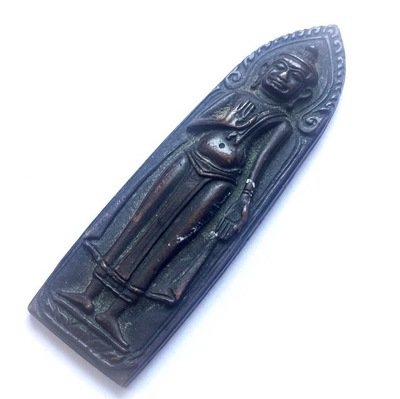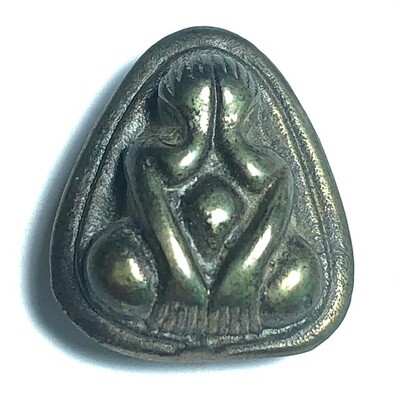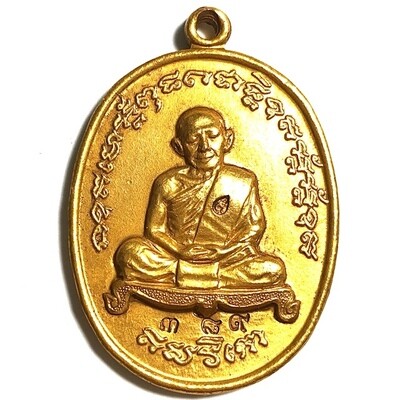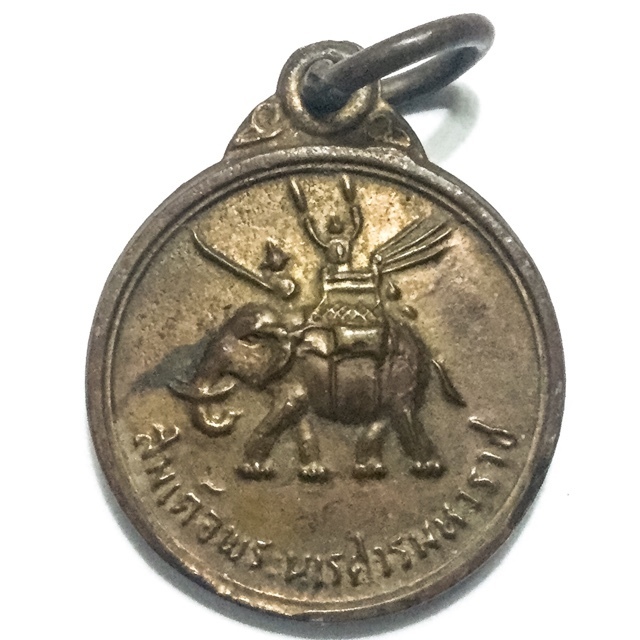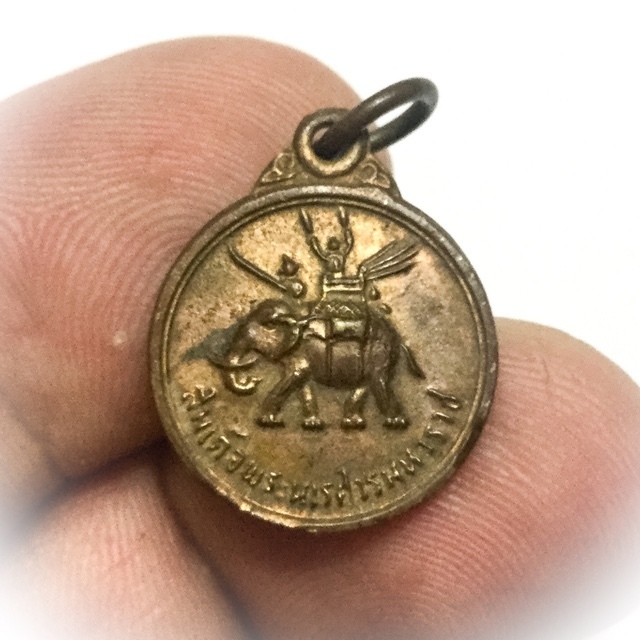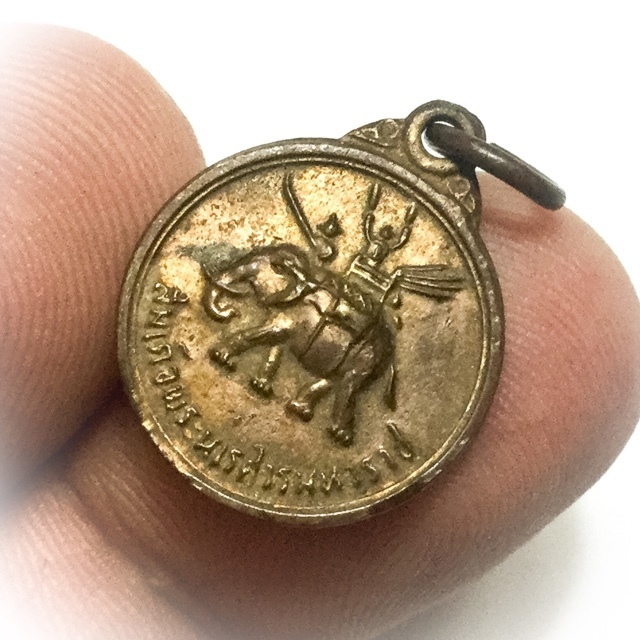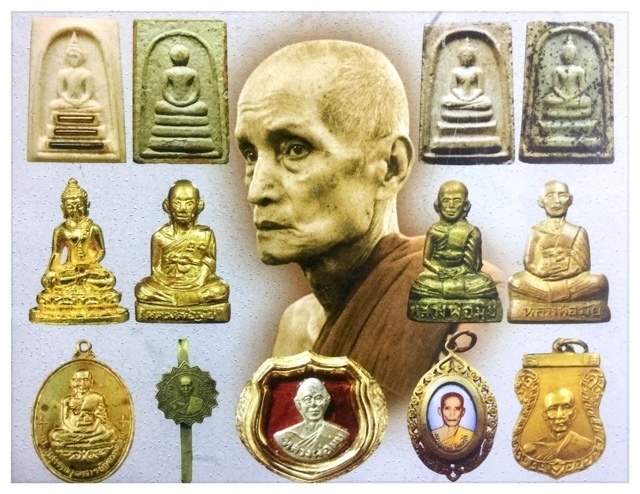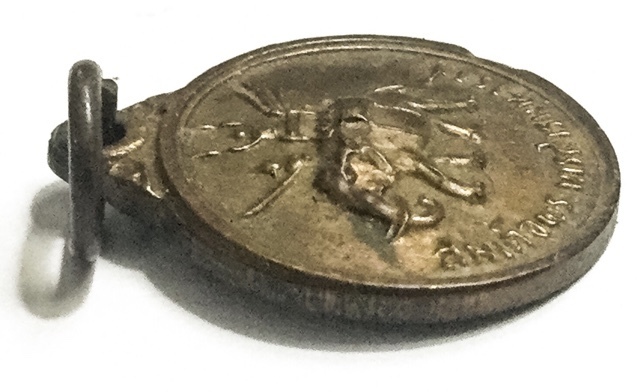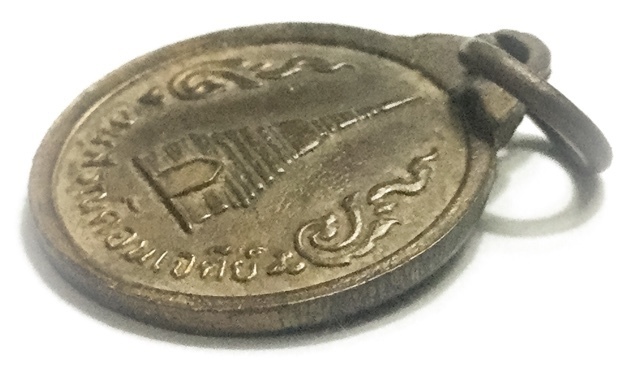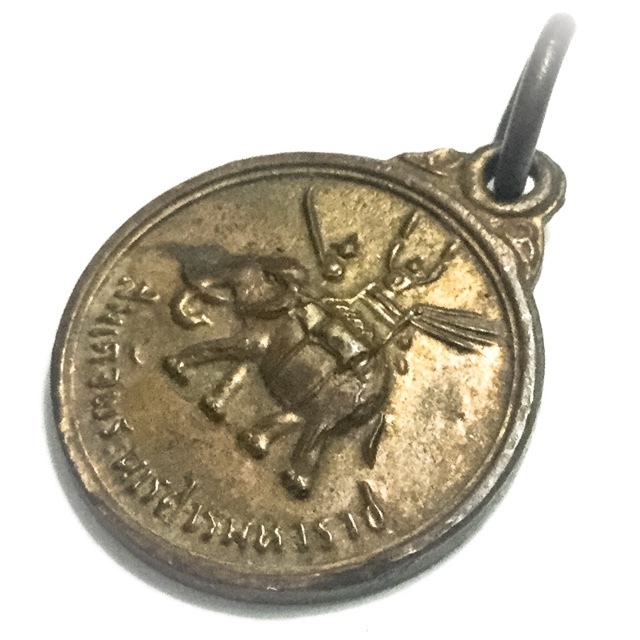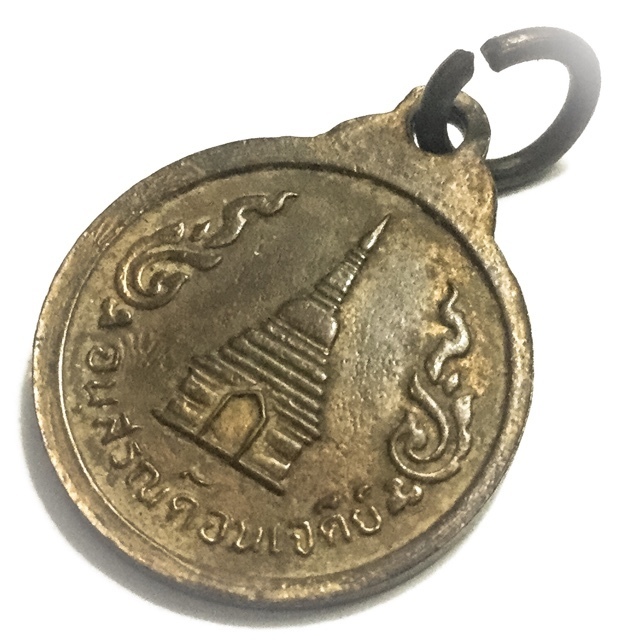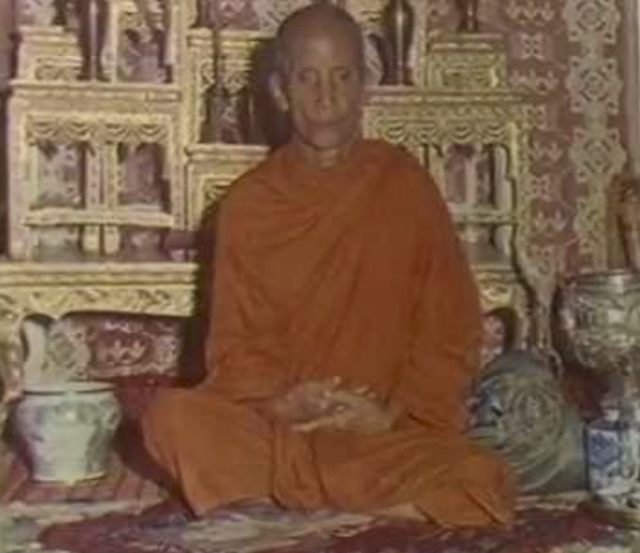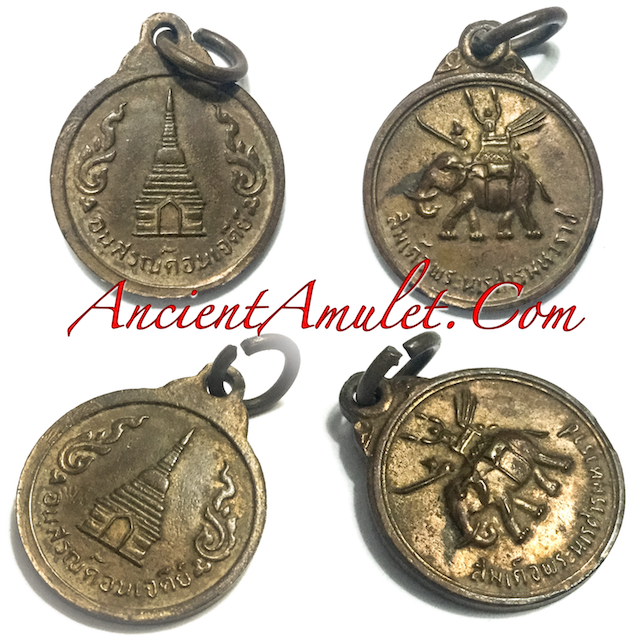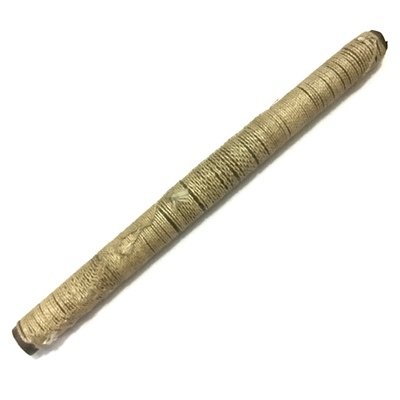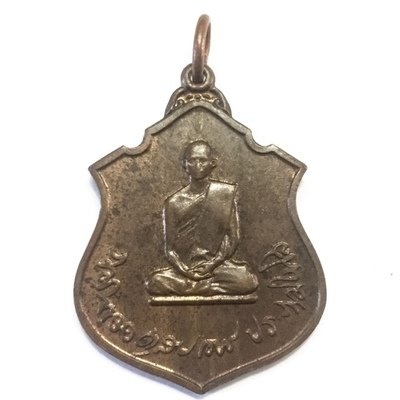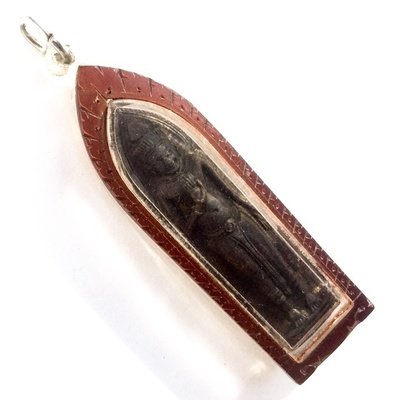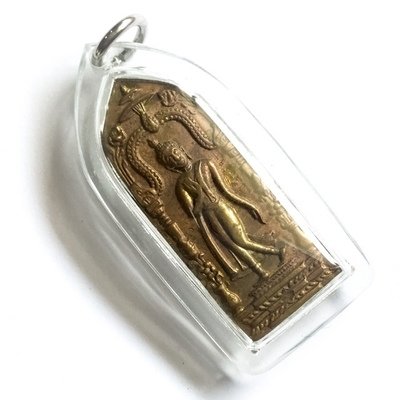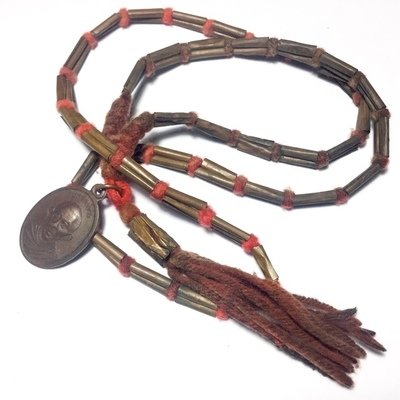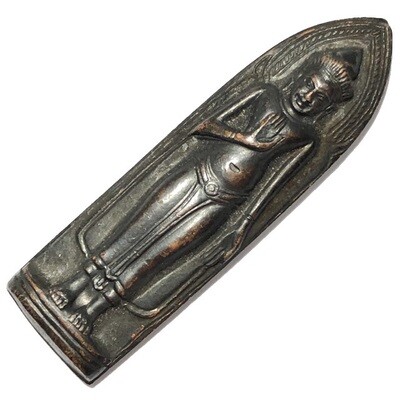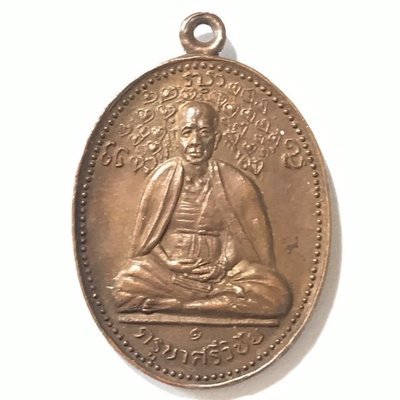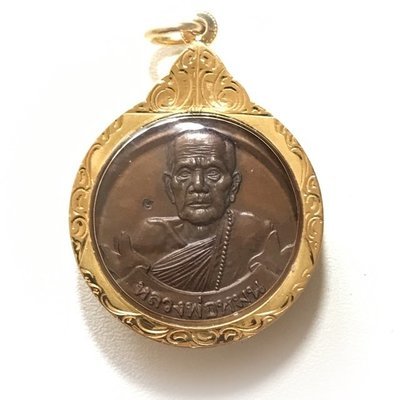Presenting a tiny but powerful and rare classic amulet from one of the Great Khao Or Masters of the 20th Century, Rian Glom Lek Hlang Chedi 2505 BE Nuea Tong Daeng Miniature Guru Monk Coin Por Tan Klai Wajasit
This Sacred amulet of the Great Khao Or Master of Nakorn Sri Tammarat, Master of Wat San Khan and Wat Pratat Noi, is a very rare amulet from Por Tan Klai’s 2505 BE Blessing Ceremony Edition, and is considered a ‘Jaek mae Krua’ type amulet (meaning ‘give to the kitchen maids and temple helpers’), which is suitable not only for men, but due to its miniature size, a perfect amulet for ladies or children to wear.

Rian Glom Lek 2505 BE Por Tan Klai Wajasit Wat Suan Khan
The 2505 BE edition of amulets of Por Tan Klai, is a highly preferred edition, which saw his famous ‘Rian Glom’ round Monk coin amulet with Chakra released, The Rian Glom Lek Hlang Chedi, and the Roop Tai Por Tan Klai Guru Monk Blesséd Photographamulets such as look om chan hmak and ya sen tobacco balls, and sacred powder amulets of various models.
A very rare and highly prized amulet for the devotees of Por Tan Klai to associate with his image and pray to him with a blessed image of the Guru, and the Chedi Relic Stupa on rear face for Buddhanussati and Marananussati. A powerful and Sacred amulet which has passed through the hands of the Guru and been blessed by him.
Por Tan Klai was one of the Top Guru Master Monks of the Last Century, and is considered one of the Four Great Masters of the Previous Generation of Lineage Masters of the Khao Or Southern Sorcery Lineage.
Kata Bucha Por Tan Klai
Rian Galai Tong Pra Naresuan Maharach Song Chang 2513 BE - Anusorn Don Chedi Stupa Memorial Edition - Luang Por Mui
A Classic amulet, the Rian Pra Naresuan Maharach Song Chang Anusorn Don Chedi is an extremely rare coin amulet, that despite being very seldom to be found, is very famous with aficionados of this Genre of amulet. This model is in Nuea Gailai Tong (Galvanised Brazen Alloy)
Comissioned by Luang Por Geb (Abbot of Wat Don Chedi, in Supanburi), and blessed in a very large Buddha Abhiseka ceremony in 2513 BE, with Luang Por Mui (Wat Don Rai) and a large number of other great Masters of the Supanburi Province.
This is because of its appearance in the Pantheon of amulets of Luang Por Mui (Wat Don Rai), and in many collector and appreciation society publications. Apart from this, the The coin is avidly collected as an essential rarity in the 'Rian Kanajarn' coin amulet niche collector circles.
The amulet is renowned for Kong Grapan Chadtri and Klaew Klaad, and Maha Amnaj (Commanding Power & Dominion) influence, and is very popular with those who serve in the Armed Forces, Police Force, and those in Governmental Jobs, or in positions of Administrative Command.
The coin measures 1 Cm in diameter featuring an image of the Statue of His Majesty King Naresuan Maharach riding into battle on an elephant, as depicted in front of the Don Chedi Monument, where a statue of King Naresuan, and a Chedi Stupa are found in Don Chedi district, in Supannburi Province. The rear face shows the Don Chedi Monument.
The Don Chedi Monument, located in Tambon Don Chedi, comprises two sites dedicated to King Naresuan the Great’s victory over Burmese forces. One is a royal monument erected in honor of the Siamese victory, whilst the other is a pagoda, or Chedi, enshrining relics.
It is chronicled that in 1592, King Naresuan the Great defeated Phra Maha Upparacha, leader of the Burmese army, in a fierce royal duel on elephant-back. As a result, Siam regained its sovereignty and freed itself from the Burmese occupiers.
The Royal Thai Army renovated the pagoda in 1952 and built a new pagoda over the ancient one. The new pagoda is 66 meters high and 36 meters wide. His Majesty the King presided over the worshipping and opening ceremony on 25 January 1959.
It is now traditional to celebrate Royal Thai Army day on January 25 at the monument. Approximately 100 meters away, people also flock to worship the statues of King Naresuan the Great and his elder sister Phra Suphankanlaya in a shrine in the compound.
Pra Kroo Suwanawutajarn, or 'Luang Por Mui, was born as one of 5 siblings, and given the name 'Chueam', but later changed his Name to 'Mui'. His Surname was 'Mee Sri Chai'. He was born on Thursday 5th December 2432 BE. His father's name was Mr. Muean, and his Mother's name was Mrs. Chang. His family were farmers.
Luang Por Mui spent his childhood much as many farmer's child would do, and lived a normal life, until he came of age and finished his national military service.
Below, Luang Por Mui Putta Ragkhidto with some of the famous amulets of the grand pantheon of amulets which Luang Por Mui created during his lifetime, which are renowned for their Klaew Klaad Kong Grapan Chadtri and Metta Maha Niyom power.
After he has served his country with the military service, he then was ordained as a Bikkhu into the Buddha Sasana, as is traditional for all Male Buddhist children in Thailand to ordain at least for a while. Luang Por Mui actually ordained twice in his lifetime, with the first time remaining ordained for a period of 10 years (exact date of ordination unknown).
But after Luang Por Mui had disrobed, he became seriously ill, and during the illness made a Vow, that if the illness would disappear, he promised to Ordain again and devote his whole life to the Buddha-Dhamma.
When the illness then faded and disappeared, he changed his name officially from 'Chueam' to 'Mui' at the same time. Luang Por then kept his promise, and sought Ordination for the second time. This time there would be no more disrobing.
The second time he ordained is recorded as having occurred at Wat Don Bupharam in Supanburi with Pra Kroo Tammasarn Raksa (Luang Por An) as his Upachaya (Ordaining Officer), and Pra Ajarn Huan, from Wat Bang Krang as his Pra Gammawājājarn (Prompting Officer). Pra Ajarn Gun was his Pra Anusāwanājarn (witness) to the Ordination. Luang Por Mui received the Dhamma Name of 'Putta Ragkhidto'
Luang Por Mui was known to have a very diligent personality, and in line with this, he began to study the many Wicha and master the Sacred Khom Sanskrit Agkhara Inscriptions. He studied Wicha Akom Dtamra Saiyasart Sorcery with a number of the great Masters of the time.
Below; The mausoleum of Luang Por Mui, where his mortal remains (relics) are kept inside a glass coffin for devotees to worship and ask for blessings.
His various Masters and Kroo Ba Ajarn included both Ordained Monks, and Lay Masters, which included amongst others; Luang Phu Sukh ( Wat Pak Klong Makham Tao), Luang Por Im (Wat Hua Khao), Luang Por An (Wat Don Bupharam), and Luang Por Bpling (Wat Wimon Pokaram).
In the year 2475 BE, Luang Por Mui was officially elected as the Abbot of Wat Don Mui. In the year 2476 BE, Luang Por Mui was given the position of Bishop of Nong Sadao Parish. In 2496 BE, Luang Por Mui was given the Status of Upachaya Ordaining Officer for the region of Sam Suk Township.
In the year 2502 Luang Por Mui was given the Honorary Title of Pra Kroo Sanyabadtr, and his name was changed in accordance to become 'Pra Kroo Suwannawutājarn'.
Luang Por Mui was a 'Pra Samatha' - an avid practitioner of Meditation, who sought solitude, and was very strict in his self control and practice of the Vinaya rules of Ordained Life. He was tireless in his duties to serve the Buddhist Faith, and the Devotees of his Region. Luang Por continued to perform one meritorious act after another, throughout his life in service of the Temple and Devotees of Wat Don Rai.
Luang Por spent many years wandering the forests on Tudong, until sometime around 2516 BE, he became iweaker and ill. He then decided to return to Wat Don Rai, where the Devotees received him with immense celebration to welcome the return of Luang Por Mui.
Luang Por Mui then remained in his old age at the temple of Wat Don Rai, until the day of his final passing on the 15th January 2517 BE, at 07:15 am at the age of 84 years old.
Below; Luang Por Mui statue and relics in glass coffin within the Monton Mausoleum
